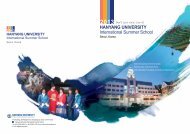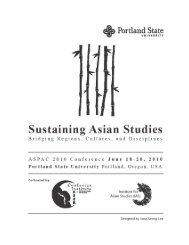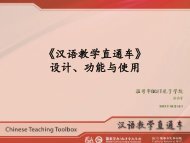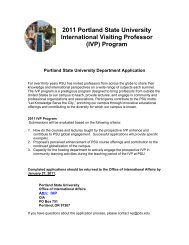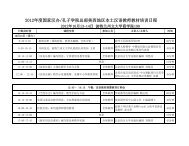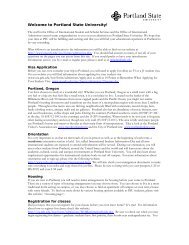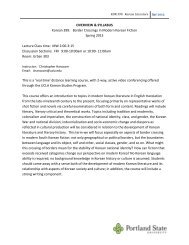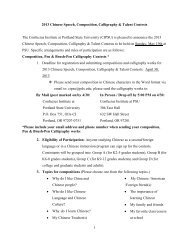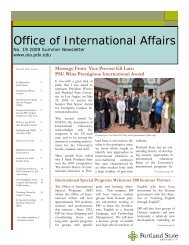ABSTRACTS - oia - Portland State University
ABSTRACTS - oia - Portland State University
ABSTRACTS - oia - Portland State University
Create successful ePaper yourself
Turn your PDF publications into a flip-book with our unique Google optimized e-Paper software.
ASPAC Conference 2010<br />
June 18 – 20, 2010 | <strong>Portland</strong>, OR<br />
According to Spada (1997), "focus on form" is any pedagogical effort which is used to draw the<br />
learner's attention to language form within a meaningful context in a course of a communicative activity. In<br />
the "focus on form" instruction, a certain linguistic form is made salient through the two major processes:<br />
input enhancement such as "input flood", "consciousness raising" and "textual enhancement", and output<br />
enhancement which is corrective feedback given to the learners after actual production.<br />
In this paper, I will present results of an analysis of communicative activities aimed at focus on form<br />
instruction presented in Benati (2009). Although Benati claims that the activities draw learner attention to<br />
grammatical forms and, at the same time, they promote communication, they lack contextualization, which is<br />
essential for communication, fail to build form-meaning connection, and disregard multiple-functions that<br />
one form bears, resulting in inefficient instruction. I will also discuss how context can be incorporated into<br />
focus on form instruction.<br />
~ ~ ~ ~ ~ ~ ~ ~ ~ ~<br />
Wingshan Ho<br />
Cross-dressing and Queer Possibilities in Hong Kong Commercial Cinema in the 90s<br />
“New queer cinema 1” poses a global call to express oneself in terms of sexuality in the current of gay and<br />
lesbian movement around the world. How or do Chinese answer the global call? Informed by gay and lesbian<br />
movements in the “West,” a gay and lesbian or tongzhi (literally comrade) identity emerged in Hong Kong in<br />
the 1990s. Popular culture, of course, has responded to the more visible identities. Hong Kong commercial<br />
cinema is a globally and locally vibrant industry. My paper argues that Hong Kong commercial cinema<br />
responded to such fervent social change by creating sexually ambiguous characters. Exposed to “western”<br />
“new queer cinema” and resonant to Hong Kong local culture, commercial cinema in the 90s used crossdressing<br />
as a technique to offer queer possibilities in response to the call of global queer identity.<br />
My paper will first map out the reason and prominence of cross-dressing in the history of Hong<br />
Kong cinema. Cross-dressing was already there in the first Hong Kong narrative film in 1913 and later saw its<br />
heyday in Cantonese opera genre in the 1950s-60s. It waned dramatically since the 1970s, but interestingly<br />
came back in the 90s. If the Chinese opera convention and the supersession of film genres mainly account for<br />
the rise and fall of cross-dressing during the earlier period, 2 then the reoccurrence of cross-dressing is<br />
associated with the social awareness of homosexuality at fin de siècle.<br />
The next section will draw on Butler’s notion of gender performativity to analyze three mainstream<br />
films involving female to male cross-dressing—He’s a Woman, She’s a Man, Who’s the Woman, Who’s the Man<br />
(Jinzhi yuye1&2) and Swordsman 2 (Xiao’ao jianghu zhi Dongfang Bubai) to explore how cross-dressing<br />
simultaneously opens up and controls queer spaces for representing unconventional mappings of sex, gender<br />
and sexualities. I will demonstrate that cross-dressed cinematic characters transform their gender identity and<br />
subjectivity in the narrative level. Cross-dressing also affords possibilities of queer spectatorship. Movie-goers<br />
may occupy multilayered viewing positions and derive pleasure through identifying with various characters<br />
which are by no means of their gender and sexual identity. Even though female to male cross-dressed<br />
characters’ subversions of fixed and unitary sex, gender and sexuality mapping are contained in a generally<br />
homophobic cinematic culture dominated by economic concerns, such spectatorship offers queer<br />
possibilities.<br />
~ ~ ~ ~ ~ ~ ~ ~ ~ ~<br />
Jon Holt<br />
Teaching Manga as Literature<br />
Despite disagreement about the status of manga, or comic books, in the Japanese literary canon, as a tool to<br />
encourage students to think about storytelling as an art form, they are indispensible. Based on my experience<br />
1 Michele Aaron ed. New queer cinema: a critical reader (Edinburgh: Edinburgh <strong>University</strong> Press, 2004).<br />
2 Xianggang diantai dianshi bu: Xianggang Zhong wen da xue xiao wai jin xiu bu, Dian guang huan ying: dianying yanjiu wen ji<br />
[Light and Shadow: anthology on of film studies](Hong Kong: Xianggang diantai dianshi bu: Xianggang Zhong wen da xue<br />
xiao wai jin xiu bu, 1985), 46-7.<br />
13



